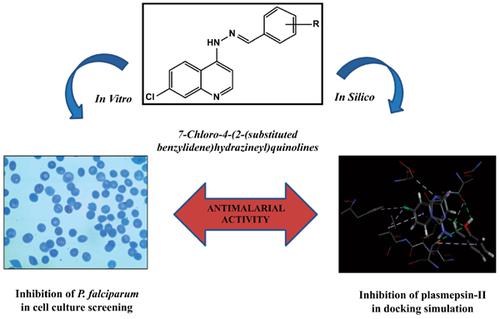Medicinal Chemistry ( IF 2.3 ) Pub Date : 2020-10-31 , DOI: 10.2174/1573406415666190806154722 Jahnabi Kalita 1 , Dipak Chetia 1 , Mithun Rudrapal 1

|
Background: Malaria is a growing infectious disease burden due to the increasing emergence of resistant strains of Plasmodium falciparum. Because of the limited therapeutic efficacy of available antimalarial drugs, the development of potent antimalarial drug agents is therefore an urgent requirement to fight against resistant malaria.
Objective: The objective of this work was to develop novel quinoline-baed antimalarial agents that would be active against resistant P. falciparum malaria.
Methods: Some 7-chloro-4-(2-(substituted benzylidene)hydrazineyl)quinolines were synthesized for the evaluation of their potential as possible antimalarial agents, particularly against resistant malaria. The antimalarial activity of synthesized compounds was evaluated in vitro against bloodstage parasites of P. falciparum. Further, molecular docking and drug-likeness including ADMET (Absorption, Distribution, Metabolism, Elimination and Toxicity) studies were also carried out using in silico tools.
Results: Results reveal the in vitro antimalarial activity of synthesized 7-chloro-4-(2-(substituted benzylidene)hydrazineyl)quinolines against P. falciparum. The docking study investigates the antimalarial effectiveness of synthesized quinolines as novel plasmepsin 2 inhibitors. Drug-likeness prediction exhibits acceptable drug-likeness and ADMET properties.
Conclusion: Based upon our findings, it is concluded that the molecular scaffold of 7-chloro-4-(2- (substituted benzylidene)hydrazineyl)quinolines may be used as a lead structure for further modifications in the search of more potent antimalarial drug molecules.
中文翻译:

7-氯-4-(2-(取代亚苄基)肼基)喹啉的设计,合成,抗疟活性和对接研究
背景:由于恶性疟原虫耐药菌株的出现,疟疾是一种日益严重的传染病负担。由于可用的抗疟药的治疗功效有限,因此开发有效的抗疟药是对抗耐药性疟疾的迫切需求。
目的:这项工作的目的是开发新的喹啉类抗疟药,它们对耐药性恶性疟原虫疟疾具有活性。
方法:合成了一些7-氯-4-(2-(取代的亚苄基)肼基)喹啉,以评估其作为可能的抗疟药,特别是抗疟疾的潜力。在体外评估了合成化合物对恶性疟原虫血液阶段寄生虫的抗疟活性。此外,还使用计算机模拟工具进行了分子对接和类似药物的研究,包括ADMET(吸收,分布,代谢,消除和毒性)研究。
结果:结果揭示了合成的7-氯-4-(2-(取代的亚苄基)肼基)喹啉类药物对恶性疟原虫的体外抗疟活性。对接研究调查了合成喹啉作为新型纤溶酶2抑制剂的抗疟疾功效。药物相似性预测显示出可接受的药物相似性和ADMET属性。
结论:根据我们的发现,可以得出结论,7-氯-4-(2-(取代的亚苄基)肼基)喹啉的分子支架可以用作先导结构,以进一步修饰以寻找更有效的抗疟药分子。



























 京公网安备 11010802027423号
京公网安备 11010802027423号